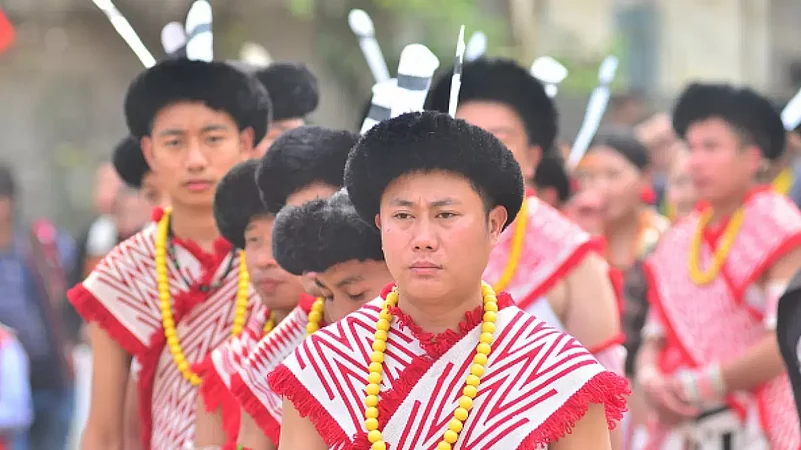According to the 2011 Census, 86.46 per cent of people in Nagaland, 86.15 per cent in Meghalaya, and 31.76 per cent in Tripura are designated as Scheduled Tribes (STs). The numbers indicate the significance of the tribal population in these three North-eastern states that will vote in the assembly election this month.
Not only is the North-eastern region socio-culturally different from the rest of India, its states are also diverse and distinct from each other in political, social, and cultural spheres. The political landscape in these states is deeply linked to the cultural identity of its people.
Here we take a deep dive into the Northeast India’s social and cultural milieu to trace the distinct cultures of the several communities in the region.
Tripura
Tripuris
One-third of the people living in Tripura are tribals. The Tripuris are the largest among the state’s 19 tribes. The community speaks the Kokborok dialect like seven other tribals groups of the state.
Tripuris belong to the Indo-Mongoloid origin and linguistically fall within the Tibeto-Burman family. For decades, they have been demanding a separate state carved out of Tripura. The statehood demand has become louder with the upcoming 2023 assembly polls in the state.

A scion of the erstwhile Tripura royalty, Pradyot Manikya, who heads the TIRPA Motha, which has spearheaded a movement for a separate state called Greater Tipraland. Before TIRPA Motha, The Indigenous People’s Front of Tripura (IPFT), the oldest tribal party of Tripura, had also raised the issue but the demand was confined to the Tripura autonomous councils. The call for Greater Tipraland, comprising areas of Tripura and Tripuris living in Assam, Mizoram, and Chittagong Hill Tracts of Bangladesh, is an extension of the old demand.
Lushai
The Lushai tribe resides in the Jampui and Shakan hills, also known as the Lushai Hills, of North Tripura on the Tripura-Mizoram border.
The Lushai belong to the Kuki-Chin group of tribes and are of Mongoloid origin. For the past four decades, Lushai people, though fewer in number in comparison to other communities, have been demanding for an autonomous district council. Their population, according to the 2011 Census, is a little over 5,000. They have also been demanding recognition of their customary law.

Meghalaya
Khasi
The Khasi tribe is indigenous to the eastern part of Meghalaya. They belong to the Austro-Asiatic group from South Asia and mostly live along the Assam-Meghalaya border and in certain parts of Bangladesh. They are the largest tribe of Meghalaya, constituting around 48 per cent of Meghalaya’s population.

For the past five decades, Hill State People's Democratic Party (HSPDP), the oldest regional political party of Meghalaya, has been demanding a separate Khasi-Jaintia state citing Article 371 of the Indian Constitution. They also demand the inclusion of Khasi and Garo languages under the Eighth Schedule to the Constitution of India.
Garo
The Garos are the second-largest tribe of Meghalaya. They mainly live in Garo Hills, Khasi Hills, and Ri-Bhoi districts in Meghalaya. They also live in Kamrup, Goalpara, Sivasagar, and Karbi Anglong districts of Assam.

For the past two decades, the Garos have been demanding a separate state called Garoland that would comprise five districts. They allege discrimination and uneven distribution of resources compared to the other two major communities of Khasis and Jaintias. All three are matrilineal. According to the 2011 Census, Garo Hills region had 13.94 lakh people.
Jaintia
The Jaintia tribe is the third-largest tribe of Meghalaya. Their habitat is confined to the West Jaintia and East Jaintia Hills districts of the state.

Also known as the Pnars, these people are of the Austro-Asiatic language stock. Apart from demanding a separate state along with the Khasis, the Jaintias in Meghalaya are also demanding more job opportunities.
Nagaland
Nagaland is inhabited by 17 major tribes — Angami, Ao, Chakhesang, Chang, Dimasa Kachari, Khiamniungan, Konyak, Kuki, Lotha, Phom, Pochury, Rengma, Sangtam, Sumi, Tikhir, Yimkhiung and Zeliang.
To most of these tribes, land remains the most important asset, both in terms of territory and survival. Over 85 per cent of the people across all tribes in Nagaland are directly dependent on agriculture and live in a thousand and odd villages situated on high hill tops or slopes overlooking verdant valleys humming with murmuring streams, according to the official government portal.
The western tribes of Angamis, Aos, Sumis, Lotha, and Kuki —the first three in particular—reside in the Kohima, Dimapur, and Mockokchung areas and are considered politically stronger. Seven tribes live in the eastern regions of the state, of which Konyak, Chang, Sangtam, and Phom communities are significant.

The eastern and western tribes are divided by terrain, the latter living closer to the plains than the eastern districts which suffer from poor connectivity and have bad roads. Due to the arrival of the British in the Western parts first, the advent of education, trade, commerce, and modern governance in the West occurred about half a century before the East. This historical and geographical disparity between the two groups has led to political fallouts for the Nagas in the form of a demand for separate statehood which has grown in the eastern districts.
Nevertheless, the Naga tribes remain united in their demand for Naga autonomy and the ‘Naga solution’. Each of the tribes has its own distinct culture and languages as well as distinct differences in customs, cuisine, artistic expression, and political systems. However, Naga tribes feel united in the need to preserve the cultural uniqueness and indigenous identity of the Nagas as well the political autonomy of the people of Nagaland. The demand for a Greater Nagalim has widespread support from all tribes.
Before conversion to Christianity, the practice of headhunting was prevalent among most of the dominant tribes. Nevertheless, headhunting is not the only identity that defines the tribes of Nagaland who trace back their ancestry to the Indo-Mongoloid bloodlines. Initially animists, the tribes converted to Christianity over the past century. At present, over 90 per cent of Naga tribals practice Christianity. The Naga tribal councils and village level administrative bodies and the civil society have played an important part in shaping the political narrative of the state and impact the day-to-day life of people in Nagaland. Though traditionally patriarchal, most tribes have today accepted modern education and gender equality.

Some of the influential tribes that live outside of Nagaland include the Rengmas in Assam, the Nokte in Arunachal Pradesh, Chen Konyaks in Myanmar, and Thangkhul in Manipur.
While anthropologists have identified 65 ethnic groups in Nagaland, 17 tribes currently have ST status.
All Naga tribes have traditionally demanded a separate country for the Naga people envisaged as Greater Nagalim which includes all lands that Nagas reside in, including the ones in other states as well as in the neighbouring Myanmar.
Angami
The word Angami is derived from a word which means “swift walker”. The Angamis are the fourth-largest Naga tribes and one of the most politically influential tribes in Nagaland, both in the political and cultural sphere. Angamis remain the only dominant tribe in Nagaland that still practice ancient animism. However, over 98 per cent of Angamis now practice Christianity.
The tribe inhabits Kohima, Chumoukedima, and Dimapur areas. According to researchers, the Angamis had a political structure resembling a sovereign state and no village chief. This was before the arrival of the British.

Angamis have been active in political leadership in Nagaland. The tribe is further divided into four major clans of the northern Angamis, western Angamis, southern Angamis, and Charoma Angamis. The majority of chief ministers in Nagaland have been from the Angami tribe, including present four-time Chief Minister Neiphiu Rio. The first woman parliamentarian in Nagaland was also from the Angami tribe.
Ao
Nagaland’s first Chief Minister P Shilu Ao belonged to the influential Ao community. The Aos have a high rate of literacy and are located in the Mokokchung district. Five-time Nagaland Chief Minister SC Jamir, who is often seen as one of the architects of present-day Nagaland, is also from the Ao community.
The Aos refer to themselves as ‘Aoer’, which means “those who came” from across the Dikhu river. Aos were once part of the eastern block of tribes which includes the Changs, Sangtams, and others of the east. It was only the crossing of the river that brought them west and arguably gave them the academic and political edge by default over the eastern bloc.

Though formerly an animist tribe that believed in ritual sacrifices and spirits, almost all members of the tribe are now Christian. The Aos are also known for their artistry and handcraft work including weaving, metal work, wood, and bamboo carving to make a variety of products. Author and ethnographer Temsula Ao was also from the community.
Sumi Naga
The Sumi Naga or Sema Nagas are yet another powerful tribe in Nagaland, historically known for their ferocious war tactics. While major chunks of their population inhabit the Zünheboto and parts of Niuland and Kiphire districts, many have migrated across to other parts of Northern Nagaland.
KL Chichi, former Chief Minister of Nagaland, was a Sumi Naga. Seven Sumi villages also exist in the Tinsukia district of Assam.

Though there was no caste or class among the Sumis, traditional Sumi society was divided on the basis of profession. Sumis, like the other Naga tribes, were also head-hunters and practiced it till the conversion to Christianity. Unlike the Angamis, the Sumis traditionally followed a “monarchical form of government”. Niloto Swu writes in Social Structure in Early Sumi Naga Society’, “In every village the apex political authority was vested on the village chiefs”.
Konyak
Konyaks are one of the most dominant tribes in the eastern districts and live in the Mon district at the easternmost tip of Nagaland.
The region suffers the brunt of having some of the most unfavourable terrain across Nagaland resulting in poor connectivity and social isolation. The Konyaks were the last among the tribal groups to accept Christianity. They are known for being fierce headhunters and were once notorious for attacking nearby villages for territory. Headhunting continued among the tribe till as recently as the 1980s.

Historians believe the term “Konyak” has been derived from the words 'Whao' meaning head and “Nyak” meaning black. Together, the words translate into “men with black hair”. The formerly fierce warriors are today a majority in the East and thus an important tribe in terms of the peace talks in Nagaland.
Roughly 3 lakh Konyaks inhabit the Mon district and are represented by civil society organisations like the Konyak Union. In 2021, the region saw days of protest and unrest after the killing of 14 local coal miners from Oting village in Mon. The Konyaks have been vocal against their mistrust for the Indian armed forces. However, the Konyaks have also been crucial in keeping the militancy of the NSCN-IM and separatist elements outside of the easternmost district and are an important part of the NNPG.
Other influential tribes include the Chants, Sangtams, and Proms in the east while Kukis and Lothar remain important in the west.


























